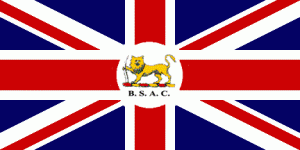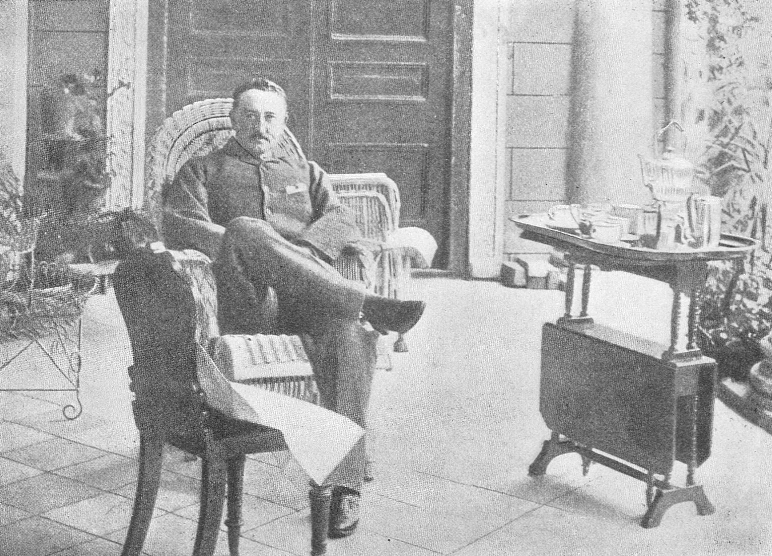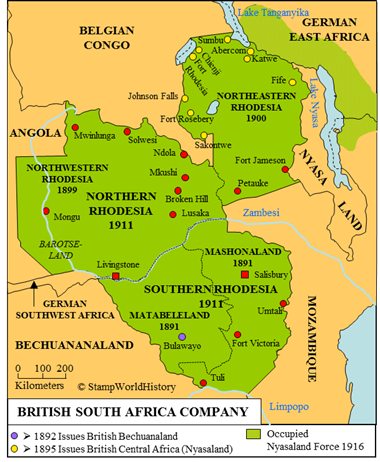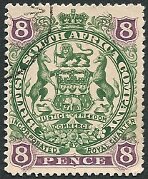
British South Africa Company
Quick reference
General issues: British chartered company 1890-1923
Country name on general issues: British South Africa Company
Currency: 1 Pound = 20 Shilling, 1 Shilling = 12 Pence 1890-1923
Population: 1 572 000 in 1911
Political history British South Africa Company
The British South Africa Company was a chartered company active in current Zambia and Zimbabwe in southern Africa. The charter of the British South Africa Company was signed in 1889. The British South Africa Company will develop its activities in a territory that, at the time, is not part of the British colonial empire and of which the borders have not yet been established. From 1895, this territory will be called Rhodesia, after the driving force behind the British South Africa Company Cecil Rhodes.
The British South Africa Company between 1889 and 1900 signs treaties with local rulers, subsequently the domains involved are put under British government protection. Thus, north of the Limpopo River, in 1891, Mashonaland and Matabeleland become British protectorates. North of the Zambesi River Barotseland is the most important kingdom. Although the British South Africa Company has already, in 1890, signed a treaty with the king of Barotseland, the British are initially reluctant to extend British rule north of the Zambesi River. It will take until 1899 and 1900 respectively that the British government acknowledges the protectorates of Northwest and Northeast Rhodesia.
The borders with the neighboring countries are agreed upon through treaties with the respective colonial powers. In 1890, the borders are defined with German East Africa and German South West Africa in a treaty with Germany and, in 1891, the borders with Angola and Mozambique are defined in a treaty with Portugal. The border with Congo Free State – that becomes Belgian C0ngo in 1908 – are defined in 1894. The borders with the British protectorates of Bechuanaland and British Central Africa are defined in 1890 and 1891 respectively.

Cecil Rhodes
The administrative division of the territory under control of the British South Africa Company changes several times until, in 1911, the protectorates of Northern and Southern Rhodesia are formed, together covering all territory under control of the British South Africa Company.
During WWI, Nyasaland and Northern Rhodesia are used by the British as a staging ground for the attack on German East Africa in 1916. A force called the Nyasaland Force[1]Also called Nyasaland Field Force and Nyasaland-Rhodesia Field Force. from 1916 occupies parts of German East Africa. The Nyasaland Force consists of recruits from Nyasaland, Northern and Southern Rhodesia and South Africa. As the Germans counter attack, part of the war is fought on the soil of Northern Rhodesia. Eventually, the British – supported by the Belgians from Belgian Congo – gain the upper hand. German East Africa is occupied and, in 1922, is split up in the British mandated territory of Tanganyika and the Belgian mandated territory of Ruanda-Urundi.
The charter of the British South Africa Company ends in 1924. In 1923, Southern Rhodesia is transferred to the British government to become the colony of Southern Rhodesia and, in 1924, Northern Rhodesia is transferred as the protectorate of Northern Rhodesia. In 1964 Northern Rhodesia will become independent as the republic of Zambia. In 1965, Southern Rhodesia will unilaterally declare independence as Rhodesia, which is recognized neither by the British nor by the international community. Independence of the former Southern Rhodesia will be recognized as the republic of Zimbabwe in 1979 .
The commercial rights of the British South Africa Company are in Southern Rhodesia transferred to the British government in 1923. In Northern Rhodesia the British South Africa Company retains a number of rights that will after independence be transferred to the government of Zambia in 1964.
Postal history British South Africa Company
The British South Africa Company issued its first stamps in 1890 for use in the territories administered by the Company. Until 1892, in the south stamps are used from British Bechuanaland for mail processed through British Bechuanaland. Similarly, until 1895, in the north stamps of British Central Africa are used for mail processed via British Central Africa. The first issue of the British South Africa Company shows the coat of arms, as do many subsequent issues. In 1896, one set of overprints on stamps of Cape of Good Hope is issued. In 1909, a set of stamps is issued overprinted ‘Rhodesia’. Subsequent issues are inscribed ‘Rhodesia’ in addition to ‘British South Africa Company’.
The stamps of the British South Africa Company are, from 1923 and 1924, respectively superseded by those of Southern and Northern Rhodesia. These to be superseded by the issues of Rhodesia – later Zimbabwe – and Zambia.
Album pages
← Previous page: British SomalilandNext page: Burkina Faso →



